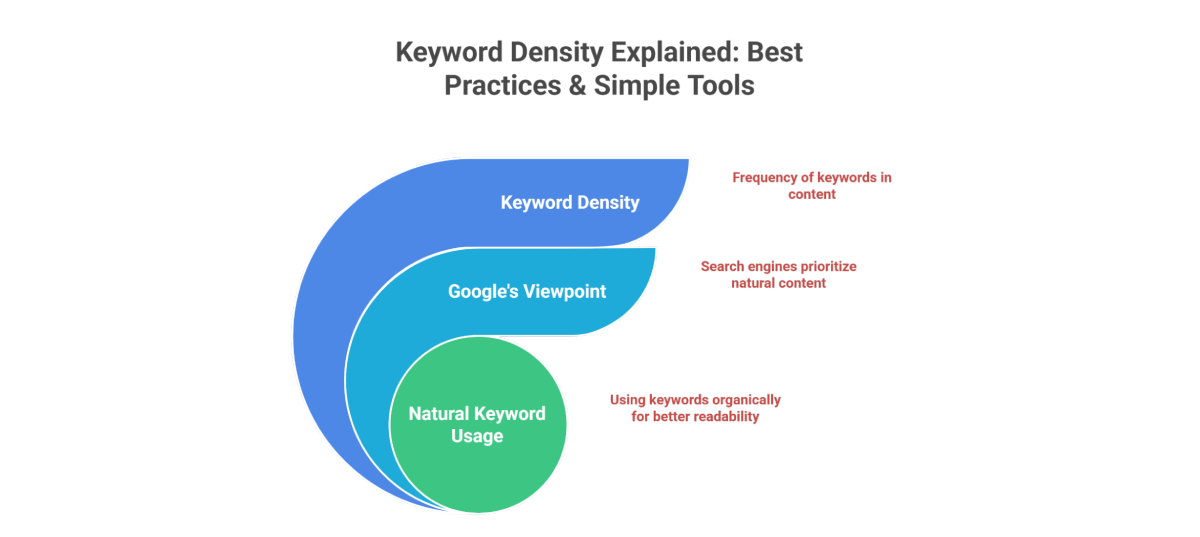The keyword density on a webpage is the number of times a keyword appears to the total number of words on the page. It helps identify the main focus keywords or phrases for that page. Although not the only factor, it remains a useful indicator for keyword relevance.
The best keyword density isn't officially defined, but some suggest 0.5% to 3% as a general guideline. It is not essential for SEO.
Maintaining this range helps confirm users landed on the correct page. For instance, seeing "wool coat" on a relevant page reassures shoppers they’re in the right spot.
We will discuss the definition of keyword density and its relevance in SEO. We will also discuss effective SEO strategies and guidelines for optimizing keyword density.
Why Does Keyword Density Matter for SEO?

Your content's keyword density measures how often your keywords appear. It was once thought to be a crucial part of SEO strategies. Today, search engines like Google do not consider keyword density a ranking factor.
Google's Viewpoint: Google has clarified that repeating a keyword excessively does not improve search rankings. It’s important to use keywords naturally rather than focusing on their frequency.
Relevance of keywords
Keywords still play a vital role in showing search engines what your content is about and helping establish your page's relevance.
- Relevance Signals: When keywords appear in headings or the body text, search engines understand that the content might be more relevant to the search query.
- Proper Placement: Use keywords naturally in your text to guide search engines and help users understand your content’s focus.
Beyond Keyword Density
While keyword density isn’t a ranking factor, other aspects are crucial in determining search engine rankings.
- User Intent: Search engines are advanced enough to understand the intent behind a query. For example, if a user searches for "best wifi printers," engines will know that articles about "best wireless printers" are relevant.
- Additional Factors: Search algorithms consider content quality, user experience, and backlinks to rank pages effectively.
Tools to Monitor Keyword Usage
Several tools can help you manage keywords efficiently and ensure your content remains relevant.
- On-Page SEO Checker: This tool provides insights into keyword usage and helps avoid keyword stuffing. It ensures your webpage is relevant without overusing keywords.
- Maintaining Relevance: Such tools help align your content with user needs and search engine guidelines, optimizing your page for better performance.
How to Check Keyword Density on Your Website: 5 Steps & Tools

Your website's optimization depends on understanding keyword density. The On-Page SEO Checker by SemRush can help you maintain the relevance of your content. Follow these steps to check keyword density effectively.
SEO Tools for Measuring Keyword Frequency
SEO tools make it easy to analyze keyword frequency. You can use them to ensure that your articles strike the right balance between keyword usage and overstuffing.
- Choose a Tool: You should choose an effective SEO tool like SemRush's On-Page SEO Checker.
- Enter Your Domain: Enter your website's domain and click "Get ideas."
- Set Up Your Project: Click “Set up” next to your project, choose your target location, and continue.
- Select Data Source: Choose “Organic Research (SemRush)” as your data source.
Step-by-Step Guide to Checking Keyword Density
Follow these steps to measure keyword density and optimize your content:
- Collect Ideas: Click “Collect ideas” to generate a report.
- Review Overview: The “Overview” tab provides various optimization suggestions.
- Optimization Ideas: Go to the “Optimization Ideas” tab and select the webpage you want to analyze.
- Content Check: Examine the “Content” section for keyword usage and potential stuffing in different webpage parts.
- Semantic Suggestions: Scroll down to “Semantic” suggestions for detailed keyword density data.
- Keyword Usage: Check the “Keyword Usage” tab to compare your keyword density with competitors.
- Keyword Phrase Usage: See how often keywords appear in the body, title, H1, and meta description.
- Keyword Occurrences: View how often a keyword appears across the entire webpage.
4 Keyword Density Best Practices

The keyword density doesn't affect rankings directly, but following best practices can help your site. It'll be easier for Google to understand your content and more appealing to users if you use these practices.
Include Keywords in Important Places
Place keywords strategically to increase your search engine visibility. You can optimize keyword placement by following these steps:
- Primary Keywords: Use them in the URL slug, meta description, introduction, title tag, and H1 tag.
- Secondary Keywords: These are synonyms or long-tail variations. They help you cover more search queries.
You should use keywords naturally. Your text shouldn't be over-optimized with them.
Cover Topics Comprehensively
It is important for search engines to display detailed and informative content. You will naturally include relevant semantic keywords with comprehensive coverage:
- Semantic Keywords: These are related terms that show you’ve covered a topic.
- Example: For "organic traffic," include "paid traffic" to explain the differences naturally.
Tools like SEO Content Templates help identify essential semantic keywords you have missed.
Prioritize Meeting Search Intent
Content optimization depends on understanding what users want. You can categorize search intent as follows:
- Informational: Users seek knowledge (e.g., "how to bake a cake").
- Navigational: Users want a specific site (e.g., "Facebook login").
- Transactional: Users aim to purchase (e.g., "buy sneakers online").
- Commercial: Users research products (e.g., "best laptops 2025").
You can tailor your content according to user intent using tools such as Keyword Overview.
Create Topic Clusters
Building topic clusters enhances your site's structure and authority. It involves:
- Pillar Pages: Cover broad topics (e.g., "Travel Tips").
- Cluster Pages: Focus on specifics (e.g., "Packing Tips for Europe").
You may improve your ranking by using this strategy, which signals to search engines that your site is a detailed resource on the topic. You can plan your content more effectively by using tools like the Keyword Magic Tool.
Conclusion
It's clear at this point that keyword density is more than just a math equation. You need to include it in your SEO toolkit as a dynamic component. Understanding and leveraging keyword density can enhance your content's effectiveness and ensure it resonates with readers and search engines.
You must seamlessly weave keywords into your content to meet the needs of your audience, not just sprinkle them here and there. Combining strategic keyword use with quality content can improve your search visibility and drive meaningful traffic to your site.
As you continue your SEO journey, consider keyword density as you create compelling content that stands out in digital landscapes.
FAQs
The ideal keyword density for a 500-word document is around 1% to 2%, meaning the keyword should appear 5 to 10 times. This range helps optimize for search engines while keeping the text natural and readable. Avoid overstuffing, as it can make the content feel forced and affect readability.
The density of specific keywords on a page is determined by the number of times each keyword appears in the total number of words. You can estimate a page's SEO effectiveness by multiplying the keywords by the total words. The quality of a page's ranking for these keywords can be determined using this metric.


